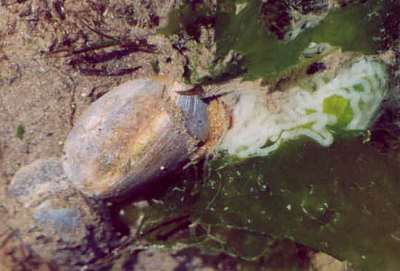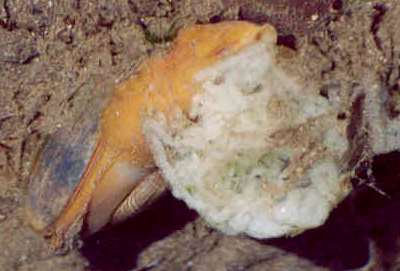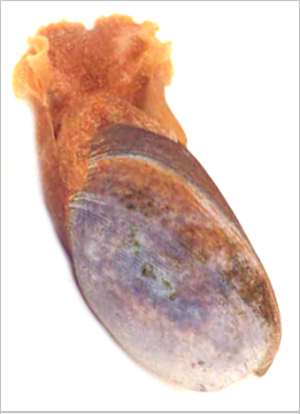Bulla quoyii - mass mortality
December 9, 2003
From: Paul Furneaux


PHOTOS: Upper - Bulla laying egg string on Ulva., Centre - egg string still emerging., Lower - aquarium photo. Bulla quoyii, Tauranga Harbour, New Zealand. 21 November 2003. Photos: Paul Furneaux.
Dear Bill,
Just a few further observations on Bulla quoyii numbers during November-December here in Tauranga, NZ, to add to my earlier messages.
Early on in November the number of Bulla individuals that would be recorded in a survey increased from 8 per survey to over 200 per survey by Nov. 21st. A peak of some 1200 to 1300 animals was seen on Nov. 29th and this had fallen away to only 25 animals by Dec. 6th, with lots of dead animals and empty shells around to indicate their fate. Egg strings followed a similar pattern but tended to be ahead of the animal numbers early in November, jumping from 19 seen on Nov. 6th, to 500-600 recorded for Nov. 21st. However, because the eggs mature quite quickly (about 10 days to release veligers in the aquarium) the numbers of egg strings never quite matched the peak numbers of animals and the greatest number was recorded on Dec. 2nd at 719.
The egg strings were attached to various substrates, mostly algae, including Ulva, Enteromorpha, Gracilaria, as well as Zostera and even empty Arachnoides exoskeletons. The mating aggregations were at their largest when the density of the animals was at its greatest - groups of 10-14 animals were common on Nov. 29th but not on other occasions. By the look of the current trend in numbers the breeding activity for Bulla in this area will be over by the end of December.
I've attached photos of animals that appear to be in the process of depositing egg strings together with a shot of one of my aquarium animals just prior to its release. (it was quite co-operative and had perhaps become used to having lights on it at any time of the day)
Regards,
Paul Furneaux.
P.Furneaux@xtra.co.nz
Furneaux, P., 2003 (Dec 9) Bulla quoyii - mass mortality. [Message in] Sea Slug Forum. Australian Museum, Sydney. Available from http://www.seaslugforum.net/find/11632
Dear Paul,
Thanks for this information. I think this definitely counts as a mass mortality event, much as occurs in many species of Sea Hare. It has all the classic features - apparent sudden appearance of many adults, much breeding activity, then sudden death of most of the population. This type of phenomenon has led to speculation about sea slugs migrating to specific breeding grounds. My feeling is that rather than migrating to a particular place, these animals are a local population that has remained unobserved as they grew because of camouflage, and/or behaviour, which made them difficult to see. In the case of Bulla quoyii I suspect juveniles and sub-adults live in the upper layers of the sandy/mud only emerging at night for feeding. When they reach full size and breeding activity begins, they begin to stay on the surface for long periods and so both the animals and their egg strings become suddenly visible. Mass mortality would also explain why at times, large numbers of empty shells can be found, but not a single live animal.
Best wishes
Bill Rudman
Related messages
-
Re: Bulla quoyii from New Zealand
From: Graham Bould, December 18, 2008 -
RE: Bulla quoyii - breeding observations
From: Rachel Przeslawski, November 19, 2003 -
Bulla quoyii - breeding observations
From: Paul Furneaux, November 18, 2003 -
Handy Hints for finding Bulla quoyii
From: Paul Furneaux, November 14, 2003 -
Bulla quoyii from South Australia
From: John Chuk, September 3, 2003 -
Re: Bulla quoyii from New Zealand
From: Audrey Falconer, September 2, 2003 -
Bulla quoyii from New Zealand
From: Paul Furneaux, September 1, 2003
